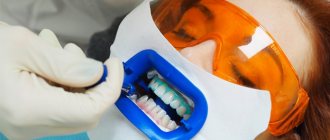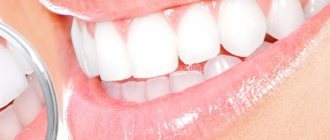The original color of orthopedic structures cannot be changed. Therefore, when making prosthetics, the dentist immediately matches the shade of the new teeth to the natural enamel of the remaining teeth. But you can not improve, but restore the lost color and shine of surfaces, almost to a new state. However, in this case, we are not talking about how to whiten dentures. In the process of special processing, it is only possible to make them lighter and remove pigment spots. It is not possible to make artificial teeth white after they are made.
Reasons for discoloration of extended teeth
The situation when the extended tooth turns yellow several years after a visit to the dentist is quite normal. Most often this is due to the quality of the materials with which the doctor performed the extension. As a rule, these are composites. They tend to accumulate odors and dyes. In addition, if they are not polished every 3-4 months, they lose their smoothness, become rough and “cling” to plaque even better, and also absorb various pigments.
Important! The extended tooth requires very careful hygienic care and also requires adherence to a certain diet, which is especially important when the restoration is performed in the frontal area of the smile. Otherwise, after a short period of time you may notice that it is different in color from the rest.
A bad habit such as smoking can cause a quick change in the shade of the restoration.
Darkening can also be caused by other serious circumstances: trauma, development of secondary caries, pulp necrosis, incorrectly or poorly treated root canals. However, then, in addition to the change in shade, you will probably be bothered by other unpleasant symptoms, for example, pain. And here the first goal will not be bleaching, but treatment. To do this, you need to seek professional help as quickly as possible.
If before the extension the doctor removed the nerve and treated the canals, then the darkening of the enamel is associated precisely with depulpation, because the tooth was deprived of its source of vital nutrition, it became “dead,” fragile and susceptible to any negative factor from the outside. A tooth can also darken from the inside due to filling the canals with resorcinol-formalin paste.
The reason that the cured one stands out in color from the rest may also be the method of its restoration. For example, if the extension was carried out on a metal pin, then the rod may be visible through the restoration materials.
How to do oral hygiene
If it is impossible to refuse drinks and foods that stain filling materials, you need to pay increased attention to hygiene. In such situations, cleaning after every meal is mandatory.
- cleaning in the morning and evening (before and after breakfast, as well as after the last meal) with a medium-hard brush,
- irrigator, dental floss, brushes and rinse for cleaning the interdental spaces after each meal and even after a regular snack.
What contributes to the darkening of crowns and dentures
It is not only the appearance of artistic restorations and fillings made using composite materials that causes dissatisfaction among patients in dental clinics. Some complain that they are not satisfied with the color of prosthetic structures made from metal-ceramics or plastic. Why is this happening?
Plastic products are similar in aesthetic and quality characteristics to those made from composites. The material is very “delicate”, it is porous, and quickly loses its aesthetics under the influence of food and drinks with dyes, from smoking, and due to lack of oral hygiene.
Metal-ceramic prostheses are a different story. And if you are going to install them in the smile area, which professional doctors strongly do not recommend doing, then you must have a clear understanding of their shortcomings:
- the metal shines through the ceramics: if the restoration is single, then this will be noticeable, especially in bright lighting,
- the metal oxidizes, so a bluish rim may appear at the border with the gum over time, which will further spoil the overall impression of your smile.
Important! In order not to think about the question of how to whiten artificial crowns and dentures installed in the smile area, initially choose the right materials from which they will be made. Ceramics and zirconium dioxide are ideal for the smile area: they do not change shade throughout their entire service life and have high aesthetics.
Recovery methods
The guaranteed service life of the extension result is on average 7 years. Upon its completion (in some cases, earlier), the need for another restoration arises. For minor damage, the procedure is repeated. More serious problems are solved by installing the following structures:
- Veneers. Onlays made of ceramics and other materials are made using impressions of the patient’s jaws. Before installing the structures, the patient's enamel is slightly prepared, which excludes the possibility of its restoration, since the enamel is not restored. If veneers wear out or break, new structures are made or dentures are installed.
- Recovery tabs. Analogs of fillings on chewing teeth are made from ceramic impressions of the patient on robotic machines, ensuring their precise contact with the walls of the teeth. During operation, the products do not deform and eliminate the risk of infection penetrating the tooth surface. The service life of the tab is up to 20 years.
- Crowns. Prosthetic replacement of the supragingival part is indicated when more than 50% of the visible part of the tooth is destroyed. Designs for the smile zone are made from aesthetically pleasing materials (ceramics, composites), for chewing teeth - from metal-ceramics, zirconium dioxide.
- Bridges. Several combined crowns are installed in the presence of supporting teeth. They are first ground and depulped, since the supports experience increased chewing load. The service life of bridges is up to 10 years.
- Implants. Structures implanted into the gums perform the tasks of the tooth root. Crowns or bridges are placed on them. The advantages of the method are minimal trauma, since the procedure does not require grinding and depulpation of adjacent units.
Is it possible to whiten restorations at home or in dentistry?
How to whiten an extended tooth at home or in dentistry? The answer will disappoint many. This is impossible to do for the reason that all bleaching agents known today act only on organic tissues (i.e. directly on enamel and dentin), destroying the pigment in them.
On a note! Patients who have removable dentures also often wonder if they can be whitened. It is impossible to do this. It is much easier to prevent darkening of materials by promptly removing food and bacterial plaque from them: cleaning tablets and professional hygiene at the dentist will help with this.
However, if the extended tooth has darkened due to depulpation, i.e. If the nerve is removed, you can try to restore its color using intracanal bleaching performed in the dentist’s office. However, it is worth remembering that the procedure can make it even more fragile and weak. It may even break off over time, which will lead to the need for removal. In addition, the effect will only be temporary; in 1-2 years everything can return to its place.
General information
Teeth extension is carried out when the crown is destroyed, not exceeding 30% of the supragingival surface. The procedure is carried out by step-by-step layering of light-curing materials on the problem area for the following indications:
- wedge-shaped defect;
- cracks, chips in enamel;
- carious lesions;
- hypoplasia of the upper layer of teeth.
During the restoration of one defect, which takes up to 2.5 hours, the doctor restores the lost area of the tooth by precisely selecting its natural shape, relief and color shade.
Negative consequences of bleaching artificial materials
When carrying out artistic restorations and prosthetics, doctors try to choose a color that matches as closely as possible the natural shade of the patient’s enamel. However, over time, both the natural enamel and the restorations themselves can darken. That's why many people think about whitening. But at the same time, not everyone is ready to take the word of the dentist that this is impossible. Some people try to do lightening at home, for example, using highly abrasive bleaching pastes, soda, hydrogen peroxide, and store-bought gels. What negative consequences can this lead to?
- neighboring teeth will become lighter, but the restoration will not change its color and will look even darker against the general background,
- Cracks, scratches and chips will appear on artificial materials: bleaching compounds aggressively affect not only the enamel, but also the restorations, they can damage them and significantly reduce their service life. Remember that the resulting cracks are secluded places for the accumulation of bacteria that provoke dental diseases.
A number of researchers1 have found that bleaching agents can destroy the strength and hardness of artificial materials and contribute to the formation of roughness on them. Moreover, products made from some materials, for example, methyl methacrylates, can become orange after exposure to peroxide and urea, and amalgam fillings can become toxic. Designs made of gold and porcelain are subject to the least negative impact.
How much should you not eat after teeth extensions?
Since anesthesia is used for recovery, you should avoid eating for 2-3 hours after the end of treatment. You need to wait until the numbness goes away completely, otherwise you may accidentally bite your lip, tongue or cheek while chewing.
Modern photopolymer dental fillings harden under the influence of a special lamp almost instantly, so the load on them will not lead to shrinkage of the material - if anesthesia was not used, you can eat right away. But it is better to give preference to softer and warmer foods.
If the tooth has been significantly damaged and a pin or stump insert was used as additional support, you should avoid eating hot or very cold food for the first 24 hours, since special dental cement was used - its fixing properties may become worse under temperature stress.
What can be done with darkened restoration
If your extended tooth turns black, there may be several options for solving the problem. All of them can be done with the help of a dentist.
Artistic extension
Patients who have teeth made of composite materials often complain of a rapid loss of smile aesthetics. However, they have the advantage that such a restoration can always be replaced with a new one. The doctor can easily grind off the old composites and apply fresh ones that will match the color. All this can be done in one visit to the clinic, and you won’t have to burden yourself with big expenses. The asking price is from 5 thousand rubles.
On a note! Has the composite material used for the extensions become dull and lost its shine? Perhaps polishing and sanding it will be enough. If you contact your dentist for this service every 3-4 months, the restoration will retain its beauty longer.
Installation of veneers or lumineers
The thinnest ceramic or zirconium dioxide plates will make your smile beautiful not for 2-3 years (as with composite restoration), but for 10 years or more. At the same time, the linings will not change their color under the influence of pigments from food and drinks, and will not lose their shine and whiteness throughout the entire period of use.
It is worth noting here that it is better to install onlays of this type on all teeth located in the smile zone at once, because otherwise they may stand out against the general background. And then it will seem that the neighboring teeth are darker than the one that was restored.
“The tooth added to the front has darkened. In principle, this was expected, because... The doctor warned that sooner or later such a problem would happen. I decided to replace it with Lumineers, but I was very upset when I learned that Lumineers can only be installed as a set, in the amount of 6-8 pieces at once, and this is a very expensive pleasure. And wait several months. After all, the originals have to be ordered from America itself. In the end, I limited myself to a couple of veneers - it turns out that it’s possible. It was really cheaper and looks really nice!”
Christina, fragment of review from otzovik.com
3, Crown installation
To avoid having to think about bleaching and constantly redoing the restoration, you can install a crown made of ceramics or zirconium dioxide. These materials are optimal for the smile area: they have the shine and color of natural enamel, retain their whiteness and performance characteristics for 10 years or more.
This option is best considered for patients whose teeth are severely damaged.
“Five years ago, I fell on the street in icy conditions and suffered a jaw injury; one front tooth, which was built up with a composite due to a slight curvature, was also broken. He had to be depulped. Then I wanted to restore it: for example, to build it up again or put in a veneer, but the doctor said that this was contraindicated, because it is now very fragile, and over time it will begin to darken due to the lack of nerve and the blackness will show through, so it is better to immediately protect it with a crown. We chose ceramic. It looks like it can’t be distinguished from the others by its color, and after years its appearance doesn’t change at all, although I don’t particularly limit myself in anything - I eat and drink whatever I want.”
Alisa Talalueva, review from 32top.ru
How to whiten tetracycline teeth?
Tooth enamel can change its color while taking tetracycline antibiotics. Teeth may become dirty yellow, brown, or dark gray. Children's teeth during the period of formation and taking antibiotics of this type are especially susceptible to color changes. It is quite difficult to whiten such teeth, since the coloring pigment is located quite deep. No home remedies or techniques will bring results. The only way out in this case is to go to the dentist and get professional whitening. In addition, there is a high probability that several procedures will be required.
What to do if your teeth still need to be whitened: what will happen to the restoration?
Do you have an extended or prosthetic tooth in the frontal area, but still want a snow-white smile? Then the sequence of actions should be as follows:
- contact your dentist for professional oral hygiene, removing bacterial plaque and deposits,
- undergo a whitening procedure, professionally, of course. Or the doctor may recommend wearing mouth guards with an individually selected concentration of the active substance in the gel at home, but then the result will become noticeable only after several weeks,
- replace old fillings, restorations or crowns with new ones: at the manufacturing stage, specialists will select a color for them that will match the new shade of the enamel that has been whitened.
Remember that any other sequence of actions is not acceptable. It is not advisable to change the restoration before bleaching, because Each patient is individual and it is unknown what shade the remaining teeth will take after the procedures.
Important! If you have had your teeth whitened and then do not try to maintain the result, you may encounter an unpleasant situation: after a few months they will begin to darken, and the newly grown or restored tooth will already look lighter against their background.
Durability of teeth whitening results Zoom 3
The results of Zoom 3 teeth whitening, performed by a certified specialist, remain durable for several years. To maintain white teeth, it is enough to brush your teeth using the Air Flow method twice a year, and your smile will sparkle for a long time. The photograph shows the appearance of the teeth two years after whitening and artistic restoration (dentist Borisova Yu.A.), when the patient underwent another professional teeth cleaning with Air Flow.
Whitening teeth under braces
Teeth with braces require special care. If the patient neglected the doctor’s recommendations, drank a lot of strong coffee or tea, then the teeth become unsightly and acquire a yellowish tint. It is better not to whiten your teeth before removing braces, because most of the tooth is under the structure. As a result, after removing braces, dark spots may form on the teeth, because... Lightening gels are not included in the design. In addition, wearing braces is stressful for tooth enamel, which endures a lot of stress. She becomes more sensitive and vulnerable. Therefore, those who wear braces have teeth that are more prone to decay. Dentists recommend postponing the whitening procedure until the system is removed.
The only sure thing for people wearing braces is to visit a dental hygienist regularly to have their teeth cleaned. This procedure will help get rid of yellow plaque.











